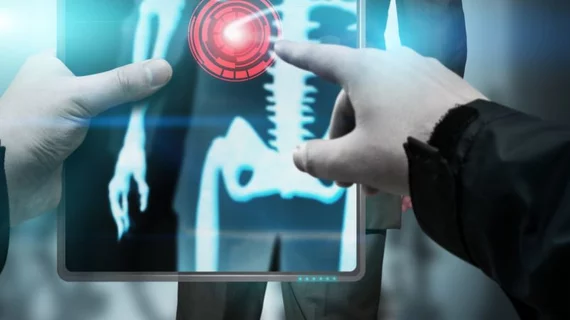Emergency radiology errors tied to adverse outcomes among patients readmitted for repeat imaging
Diagnostic errors on patients’ initial emergency imaging exams are “strongly” associated with adverse outcomes among those readmitted to the ED for repeat imaging, researchers reported Wednesday.
Unplanned revisits to the ED are known indicators of quality and have been proposed as markers of medical errors. But there’s little insight into emergency radiology’s role in this issue and potential association with outcomes.
Researchers looked within their own tertiary hospital for clues, sharing a number of important takeaways for the specialty Nov. 3 in Insights into Imaging.
For instance, the rate of delayed operations and other adverse outcomes (AOs) related to errors was higher among those who came back to the ED for repeat imaging within 3 days compared to patients who didn’t experience errors (36% vs. 12%). And these mistakes were most prevalent among those with neurologic and digestive diseases.
The authors believe zeroing in on revisits with repeat imaging (RVRI) may serve as a good quality indicator for emergency radiology services going forward.
“Our study underscore[s] the importance of minimizing diagnostic errors in emergency imaging studies to reduce adverse outcomes and improve emergency care,” Yura Ahn, MD, with Asan Medical Center’s Department of Radiology and Research Institute of Radiology in Seoul, South Korea, and co-authors wrote. “Strategies such as reviewing RVRIs, the adverse outcomes of patients, and error documentations may reduce the diagnostic error rate over time,” they added later.
For their study, Ahn et al. retrospectively assessed errors resulting from index imaging studies and associated adverse outcomes within 30 days across 1,054 revisits with repeat imaging. They included people who came back to the same ED within 7 days of discharge between 2005-2015, keying in on repeat CT and MRI scans.
Overall, adverse outcomes occurred in 33.3% of those in the diagnostic error group compared to 14.8% in the non-error cohort. Digestive diseases were the most commonly misdiagnosed conditions by radiologists (28 of 59 cases or 47.5%), along with neurologic diseases due to delayed reporting (29 of 62 cases, 46.8%).
The group noted providers should pay close attention to early ED revisitors with potential neurologic or digestive diseases, adding index CT scans may better triage patients prior to additional imaging exams.
“Our data imply that regardless of the revisit timing, emergency radiologists should consider the possibility of misdiagnosis stemming from index imaging among returning patients who require repeat imaging,” the authors concluded.
Read the full study here.

